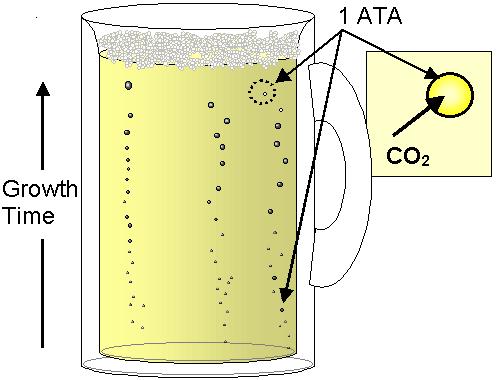|
|
Beer
|
|

|
||
|
A freshly poured glass of beer or Champagne illustrates some general physical properties of bubbles. In beer, CO2 is dissolved under tension in the liquid. While the cap is in place, equilibrium exists between dissolved gas and any bubbles that may have formed. As soon as the bottle is opened, equilibrium is disrupted and bubbles grow explosively due to the reduction of pressure (Boyle's Law) and the flow of CO2 from solution into the bubbles (Diffusion). Free vs. Dissolved Gas |
||
| A clear picture of the differences in terminology and physics of dissolved and free gases is essential for understanding bubbles. Free gas, in the form of vapor, is partially characterized by its | Fig. B1. A glass of beer models bubbles in the body. | |
hydrostatic
pressure. Dissolved gas is said to be under tension, with
the units of both tension and pressure being force per area (for example:
pounds-per-square-inch). In beer, free
gas is indirectly visible by bubble skin boundaries with the liquid.
While the dissolved gas is not visible in beer, we can taste a little
sharpness due to the CO2 in solution.
NucleationBefore a bubble can grow, it must form --or nucleate. In beer, bubble nuclei form at imperfections on surfaces such as scratches on the glass rather than within the body of the liquid. In humans, nuclei might form at crevices and cavities in tissues. Other possible bubble nucleation mechanisms include environmental radiation and cosmic rays (!), carbonated beverages, and exercise-induced cavitation (tribonucleation). CavitationShaking beer before opening is poor manners, though as scientists, we may be excused from social indiscretion.... When beer is agitated, cavities form small bubbles, which then collect as foam on the surface. If you then open the bottle, and explosively decompress the beer, the foam eruption is the work of Boyle's law and inflation by diffusion. On the other hand, if the shaken beer is allowed to sit for awhile and "decompress," the gas in the bubbles will be driven back into solution by the bubble skin tension (see Balloons) --making it safe to open. Within a decompressing diver's body, analogies might be tissue cavitation caused by exercise and synovial cavitation due to shearing forces in the joints. Hence, the recommendations to avoid vigorous exercise after diving to avoid cavity formation. Regardless of their origin, microscopic bubble nuclei exist in all aqueous media ...and we divers are mostly water.... So, just as in beer, nuclei in divers are susceptible to growth during decompression. DiffusionFrom nucleation sites on the glass, columns of bubbles rise to the surface where they form a foamy head. In a tall glass, bubbles grow two or more times in diameter before surfacing. We might first assume that this is Boyle's law at work, with bubbles expanding as they rise due to lower hydrostatic pressure. However, it would require a 33-foot (10-meter) tall glass for a bubble to double in volume by rising to the top --so something else must be happening. Because hydrostatic pressure is essentially the same at the top and bottom of the glass, we don't expect much change in bubble size due to Boyle's law. It is therefore the diffusion of gas into bubbles that is primarily responsible for their growth. During the time it takes a bubble to rise in a glass of beer, CO2 dissolved in the liquid flows into a free, gaseous phase in the bubble. This is analogous to bubble growth in a diver by inward diffusion of inert gas from surrounding tissue. Bubble SkinsBreweries that use traditional ingredients produce beer that naturally forms a rich, foamy head. This is where problems arise for manufacturers of thin, light beer. They add chemicals to give bubbles skins so foam will form. This is not only important for divers who want a quality beverage, for it is likely that bubbles formed within our bodies also have skins of surfactant molecules. In the development of the VPM, Yount, et-al proposed that biological surfactant molecules surround bubbles in the body and stabilize them from collapsing. This persistence is bad news for divers because the bubbles can be excited into growth by diving days or weeks after they initially form. Exceptions to this situation may well be found in those divers who dive frequently and deep (>270 ffw) because their tissues may be denucleated by pressures that are sufficient to collapse the nuclei. |
||
